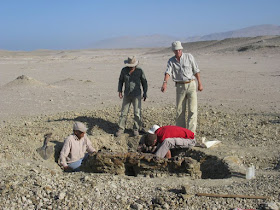 |
| Mystacodon selenensis
Lambert, Martínez-Cáceres, Bianucci, Celma, Salas-Gismondi, Steurbaut, Urbina & Muizon, 2017
DOI: 10.1016/j.cub.2017.04.026 |
Highlights
• An ancient whale is described based on a skeleton from the late Eocene of Peru
• It is identified as the earliest known mysticete (baleen whales and relatives)
• Skeletal anatomy provides crucial information on archaeocete-mysticete transition
• This whale is interpreted as specialized for suction and possibly benthic feeding
Summary
Although combined molecular and morphological analyses point to a late middle Eocene (38–39 million years ago) origin for the clade Neoceti (Odontoceti, echolocating toothed whales plus Mysticeti, baleen whales, and relatives), the oldest known mysticete fossil dates from the latest Eocene (about 34 million years ago) of Antarctica. Considering that the latter is not the most stemward mysticete in recent phylogenies and that Oligocene toothed mysticetes display a broad morphological disparity most likely corresponding to contrasted ecological niches, the origin of mysticetes from a basilosaurid ancestor and its drivers are currently poorly understood. Based on an articulated cetacean skeleton from the early late Eocene (Priabonian, around 36.4 million years ago) of the Pisco Basin, Peru, we describe a new archaic tooth-bearing mysticete, Mystacodon selenensis gen. et sp. nov. Being the geologically oldest neocete (crown group cetacean) and the earliest mysticete to branch off described so far, the new taxon is interpreted as morphologically intermediate between basilosaurids and later toothed mysticetes, providing thus crucial information about the anatomy of the skull, forelimb, and innominate at these critical initial stages of mysticete evolution. Major changes in the morphology of the oral apparatus (including tooth wear) and flipper compared to basilosaurids suggest that suction and possibly benthic feeding represented key, early ecological traits accompanying the emergence of modern filter-feeding baleen whales’ ancestors.
Systematics
Cetacea
Pelagiceti
Neoceti
Mysticeti
Mystacodontidae fam. nov.
Mystacodon selenensis gen. et sp. nov.
Etymology: From ancient Greek mystacos (“moustache”) in reference to the suborder Mysticeti and odontos (“tooth”), “mysticete with teeth,” and from Selene, the Greek goddess of the moon, in reference to the Playa Media Luna type locality.
 |
| Two Mystacodon selenensis individuals diving down to catch eagle rays along the seafloor of a shallow cove off the coast of present-day Peru.
Illustration: Alberto Gennari
|
Holotype: Museo de Historia Natural, Universidad Nacional Mayor de San Marcos (MUSM; Lima, Peru) 1917, partial skeleton including cranium, mandibles, teeth, cervical, thoracic, lumbar and caudal vertebrae, ribs, partial right and left forelimbs, and left innominate.
Locality: Playa Media Luna, southern part of Pisco Basin, southern coast of Peru, ...
Horizon: Middle part of the Yumaque Formation, 77 m above the base; lower part of calcareous nannofossil zone NP19/20 of Martini; dated at 36.4 million years ago based on age estimations used by Agnini et al. [2014]; early late Eocene (early Priabonian; see Figures S1A and S1D, Table S1, and STAR Methods for the biostratigraphic and biochronological interpretations).
Diagnosis: MUSM 1917 is identified as a Neoceti based on the following derived characters, absent in basilosaurid archaeocetes: partly open mesorostral groove; anteroposteriorly elongated rostral portion of maxilla; loss of sagittal crest; supraoccipital shield anterodorsally inclined; apex of zygomatic process of squamosal nearly contacting postorbital process of frontal; and distal epiphysis of the humerus divided in two angled radial and ulnar facets. It can be referred to the Mysticeti due to the following combination of derived characters: dorsoventrally thin lateral edge of maxilla on rostrum; presence of an antorbital process of the maxilla; presence of a maxillary infraorbital plate; and triangular supraoccipital shield. It is further diagnosed by two possibly autapomorphic features: nasal anteroposteriorly longer than frontal plus parietal and strong tuberosity on anterior edge of radius; two additional derived characters: posteriormost upper tooth anterior to level of antorbital process of maxilla and broad-based rostrum (ratio between width of skull at rostrum base and width at postorbital process > 0.8); and a series of plesiomophic features: supraoccipital shield not extending anterior to anterior level of squamosal fossa, only two dorsal infraorbital foramina, a basilosaurid dental formula 3.1.4.2/3.1.4.3, no wide diastemata between posterior cheek teeth, sutured mandibular symphysis, and well-defined acetabulum on innominate. Finally, MUSM 1917 lacks cranial synapomorphies of Odontoceti: facial concavity, presence of premaxillary foramen and premaxillary sac fossa, and posterior expansion of maxilla over the supraorbital region (Figures 1, 2, 3, and S2).
 |
| Members of the excavation team digging around the skeleton of Mystacodon selenensis at the Media Luna locality in the Pisco Basin, Peru.
photo: Giovanni Bianucci
|
Olivier Lambert, Manuel Martínez-Cáceres, Giovanni Bianucci, Claudio Di Celma, Rodolfo Salas-Gismondi, Etienne Steurbaut, Mario Urbina and Christian de Muizon. 2017. Earliest Mysticete from the Late Eocene of Peru Sheds New Light on the Origin of Baleen Whales. Current Biology. In Press. DOI: 10.1016/j.cub.2017.04.026
36m-year-old fossil discovery is missing link in whale evolution, say researchers TheGuardian.com/science/2017/may/11/36m-year-old-fossil-discovery-is-missing-link-in-whale-evolution-say-researchers-mystacodon-selenensis
Baleen whales' ancestors were toothy suction feeders http://phy.so/413697728 via @physorg_com
This ancient whale likely sucked prey into its mouth like a giant vacuum cleaner https://www.theverge.com/tldr/2017/5/11/15610764/mysticete-whale-ancestor-suction-feeder-evolution via @Verge




